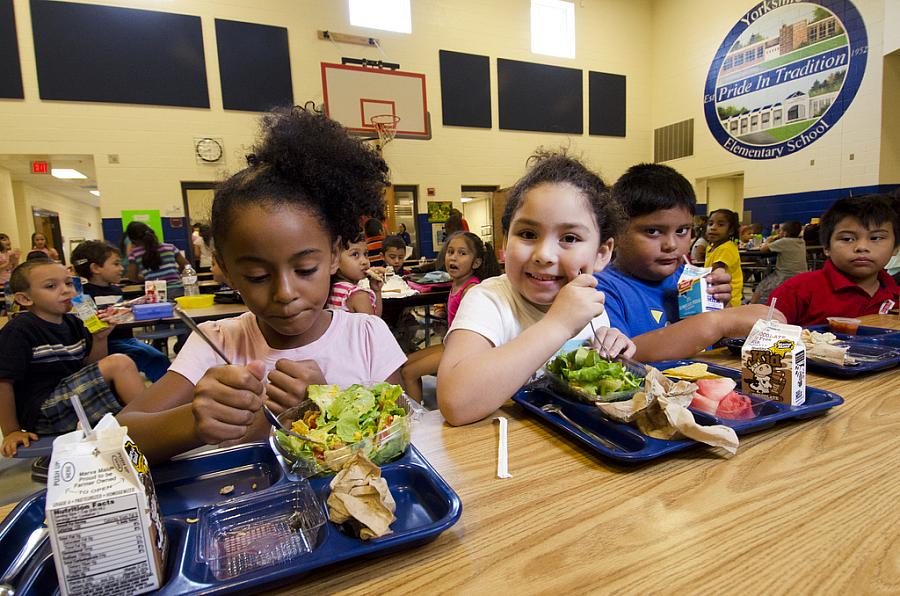Critics fight proposals to weaken healthier school lunch rules

Congress doesn’t have the most sterling record when it comes to school lunch nutrition. In one now-famous bit of legislative sausage-making in 2011, legislators blocked new rules that would’ve made it harder for schools to count pizza sauce as a vegetable serving.
With that kind of precedent, it’s not hard to see why advocates for more nutritious school lunches are rallying the troops this week as a House appropriations subcommittee moved to weaken new school lunch requirements championed by Michelle Obama and authorized by the 2010 Healthy, Hunger-Free Kids Act.
Last week, Politico’s Helena Bottemiller Evich reported on possible changes, including language that could “potentially halt key school nutrition regulations for increased whole-grain requirements and competitive foods restrictions,” set to kick in this July.
The House subcommittee discussed the bill on Tuesday. Michelle Obama was busy making troop-rallying calls on Monday to defend the stronger standards, according to the AP.
Critics argue the new rules – phased in over the past two years with more coming online this summer – are expensive and overly prescriptive and don’t give schools enough flexibility. AP’s Mary Jane Jalonick details a few of the complaints:
While many schools have had success putting the rules in place, others have said they are too restrictive and costly. Schools pushing for changes say limits on sodium and requirements for whole grains have proven particularly difficult, while some school officials say kids are throwing fruits and vegetables they are required to take in the trash.
A coalition of more than 40 lawmakers is requesting that the USDA water down or delay implementation of the stricter standards, Politico reports. Among the suggestions: keep the whole grain requirement at 50 percent rather 100 percent this year and suspend the tighter sodium limits planned for 2017.
Rep. Robert Aderholt (R-Alabama), chair of the subcommittee, recently met with Alabama school nutrition professionals, as well as School Nutrition Association’s national president Leah Schmidt. Her group, representing school cafeteria workers as school food purveyors, supports delaying or diluting the new requirements.
“It is clear to me that it is time for the Administration to hit the pause button on the implementation of school nutrition guidelines and listen to the feedback. Some of the rules are unworkable and having the opposite effect,” Aderholt said. “I am hearing this from the school administrators, as well as the students themselves.”
On Tuesday, the USDA announced that schools having difficulty serving whole-grain pastas may serve traditional pasta for another two years “as industry works to develop healthy pasta that works for schools.”
House Republicans have also proposed creating a waiver to allow a school to opt out of the tighter standards if its food program loses money over six months.
These proposals are heresy to healthy school lunch advocates.
“By allowing school districts to opt out of school nutrition standards, House Republicans are opening up the floodgates to let all the old junk food back into schools, while crowding out the fruits, vegetables and whole grains that have been gaining ground in the program,” said Margo Wootan, nutrition policy director of the Center for Science in the Public Interest, in a statement.
The American Public Health Association has compiled an exhaustive list of health-related organizations that oppose weakening the school lunch rules, including the American Heart Association, the American Medical Association and the Children’s Defense Fund.
U.S. Agriculture Secretary Tom Vilsack also sharply criticized the proposed changes this week: “School nutrition standards are developed by independent experts, over 90 percent of schools report that they are successfully implementing them, and studies show they are working to help kids be healthier,” he said.
But you don’t have to side with the macaroni-and-cheese camp to concede that the challenges for school lunch programs are real. As any parent knows, getting kids to scarf down the healthy stuff is a challenge. AP’s Jalonick turned up this gem of a quote, which lays bare the lunch lady’s plight:
“If the kids don't eat the food, then all I have is healthy trash cans,” said Peggy Lawrence, director of nutrition for Rockdale County Public Schools in Georgia.
Lawrence’s witticism raises the question of whether full trash cans call for rolling back standards or looking for other ways to make healthier school lunches more palatable to kids. Are there any new innovations in the stodgy realm of school cafeterias?
San Francisco Unified School District thinks so. Starting last spring, the city’s public schools teamed with the design firm IDEO to re-think how students eat. If schools can offer students a more engaging experience, the thinking goes, then maybe healthier eating will follow. Some of the ideas tested in the collaboration include eating family style at round tables, ordering lunch via apps that offer discounts for healthier foods and allowing students to help design dining areas or serve each other.
The district is enthusiastic, but the model is very much an experiment in progress. “IDEO’s plan is sprawling, and it’s true that the school district can’t meet every suggestion,” Liz Stinson writes in Wired. “But the district plans to implement parts of it, beginning at Willie Brown Middle School in the Bayview-Hunters Point neighborhood in 2015.”
It’s an experiment worth following. Drawing on kids’ input and re-imagining the school lunch as a social experience just might offer a promising route for keeping kids healthy and trash cans empty.
Photo by U.S. Dept. of Agriculture via Flickr.

